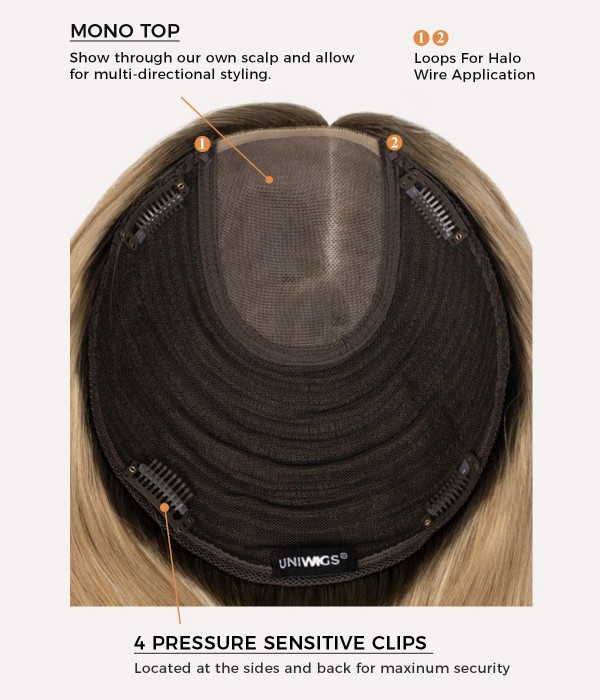
Hair Topper 101: Find Your PERFECT Match
If you’re one of the many women dealing with thinning hair or looking to add volume to your locks, hair toppers for women (and specifically hair toppers for thinning hair) can be a game-changer. But with so many options—from base sizes to hair types—finding the right one feels overwhelming. This guide breaks down everything you need to know to find your perfect match, including tips for choosing the best human hair toppers and nailing a natural blend.

Step 1 – Choose the Right Base Size for Your Needs
The first (and most critical) decision when shopping for a hair topper is the base size. It directly impacts coverage, blending, and how natural your topper looks. Here’s how to pick:
Small Bases (5.5×5.5 inches or smaller)
Ideal for: Adding volume to the crown or covering tiny patches (e.g., small scars). If you only need a little extra fullness on top (and your hair is thick elsewhere), a small base works. For example, a 5.5×5.5-inch topper is lightweight and easy to secure—but be cautious: smaller bases can make blending trickier, especially if you have more than minimal thinning.
3-x-4-velora-lace-top-human-hair-topper-ultra-breathable
Medium to Large Bases (7×8 inches or larger)
Ideal for: Hair toppers for thinning hair (covering wider areas of hair loss or thinning all over the crown). If you’re hiding noticeable hair loss or scars, a larger base (like 7×8 or 9×9 inches) is better. As I tested, a 5.5×5.5-inch topper left gaps where my natural hair peeked through, but a 7×8-inch base fully covered my thinning areas. Larger bases also blend more seamlessly—no awkward lines between your natural hair and the topper.
7-x-8-upgrade-courtney-mono-top-human-hair-topper 7-x-8-upgrade-courtney-mono-top-human-hair-topper

Step 2 – Understand Cap Construction (Mono, Lace, Silk)
The cap (or base) construction determines how realistic your topper looks, how durable it is, and where you can wear it. Let’s compare the three most popular types:
Mono Top Toppers – Great for Beginners
Mono tops have a see-through, mesh-like section where you can adjust the part (perfect for a natural part line!). The rest of the cap uses wefted hair (hair sewn into strips of fabric), making it durable and easy to care for.
- Pros: Easy to blend, lightweight, and affordable. Great if you’re new to hair toppers for women.
- Cons: Slightly see-through (you might spot small knots). Fix this by dusting a little foundation powder on the base.
- Best for: Wearing behind your hairline (not ideal for front hairlines, as it’s more noticeable).
Lace Top Toppers – For Front Hairline Coverage
Lace tops are similar to mono tops but use ultra-thin, transparent lace (even more natural-looking!). The lace extends to the front of the topper, making it perfect for receding hairlines or wearing the topper at your hairline.
- Pros: Super lightweight, can be glued down for a secure fit, and blends seamlessly at the front.
- Cons: Delicate (can fray over time) and requires more care than mono tops.
- Best for: Anyone wanting to cover a receding hairline or style the topper forward.
Silk Top Toppers – The Most Realistic Scalp Look
Silk tops have a non-transparent base that mimics the look of real scalp—it’s indistinguishable from your natural skin. They’re ideal for more progressive hair loss but still want flexibility (no full wig required!).
- Pros: Ultra-realistic scalp, can be worn at the front or behind the hairline, and works well with bangs (bangs make blending even easier!).
- Cons: Thicker base (blending takes a little more effort if you skip bangs). Use hair-building fibers at the transition line to hide gaps.
- Best for: Hair toppers for thinning hair where realism is a top priority.
Step 3 – Pick the Right Length (Avoid This Common Mistake!)
Length is key to a natural blend—get this wrong, and your topper will stick out like a sore thumb. Here’s the rule of thumb:
Opt for 1–2 Inches Longer Than Your Natural Hair
My natural hair is 15 inches long, so I always choose a topper that’s 16–17 inches (like the Upgraded Courtney topper). Why? Longer topper hair “melts” into your natural hair—you can’t tell where your hair ends and the topper begins.
- Example: A 16-inch topper hides my thinner natural hair completely. Blending takes 2 minutes max.
What to Avoid
- Too long (4–5 inches longer): Your shorter natural hair will peek through, creating awkward layers. It’s doable if you love long hair, but blending takes extra work.
- Shorter than your natural hair: This is a disaster! As I showed with the Breeze lace topper (shorter than my hair), you’ll clearly see where the topper ends—total eyesore.
- Pro tip: If your topper is too long, trim it (or have a stylist do it). If it’s too short, you’ll need to trim your natural hair to match.
Step 4 – Choose Hair Type & Color (Synthetic vs. Human Hair)
The final step is picking hair type (synthetic or human) and color. This is where you’ll decide if you want best human hair toppers or a low-maintenance synthetic option.
Synthetic vs. Human Hair Toppers
- Synthetic toppers: Affordable, durable, and pre-styled (they hold curls/waves all day). Great if you want easy care and don’t style your hair often.
- Human hair toppers (Remy is best): These are my favorite! Remy human hair (where the cuticles are aligned) looks and feels like your natural hair—you can style it with heat (curling irons, straighteners), wash it, and even dye it (lightly). They’re more expensive, but worth it for realism and versatility.
- Pro tip: If you’re used to styling your own hair, the best human hair toppers will feel most natural.
Color Matching – Focus on the Roots!
You don’t need a perfect color match—but you do need your topper’s roots to match your natural hair roots. Here’s why:
- The root area is where the topper meets your scalp—if roots clash, the blend fails.
- Example: My natural hair has highlighted ends and dark roots. I wear the Upgraded Courtney topper in “Vanilla Butter Blonde” because its roots match my dark growth, and the highlights blend with my ends.
- Pro tip: Don’t stress about slight variations! Most people have multiple tones in their hair (darker undersides, lighter tops), so a little mismatch is normal. Try shades like “Light Permafrost” or “Dusty Ash” if you have highlights—they’re forgiving.
Final Tips to Find Your Perfect Topper
- Test base size first: If you’re unsure, start with a medium base (7×8 inches)—it works for most thinning patterns.
- Prioritize scalp realism: If you wear your hair up or pull it back, a silk top is worth the investment.
- Buy from trusted brands: Brands like Uniwigs (maker of the Upgraded Courtney topper) offer quality, best human hair toppers and clear size guides.

At the end of the day, the best topper is one that makes you feel confident—no one will know you’re wearing it if it fits, blends, and matches your style. Have questions? Drop a comment below, I’m here to help!